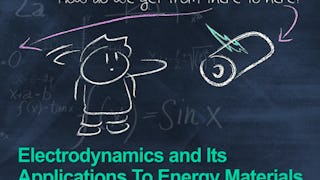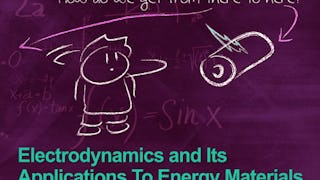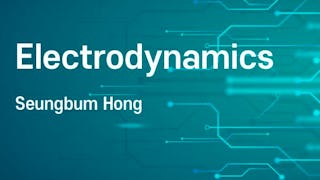This course is the fourth course in the Electrodynamics series, and is directly proceeded by Electrodynamics: Electric and Magnetic Fields. Previously, we have learned about visualization of fields and solutions which were not time dependent. Here, we will return to Maxwell's Equations and use them to produce wave equations which can be used to analyze complex systems, such as oscillating dipoles. We will also introduce AC circuits, and how they can be simplified, solved, and applied.



Electrodynamics: In-depth Solutions for Maxwell’s Equations
This course is part of Electrodynamics Specialization

Instructor: Seungbum Hong
7,785 already enrolled
Included with 
(115 reviews)
Skills you'll gain
Details to know

Add to your LinkedIn profile
5 assignments
See how employees at top companies are mastering in-demand skills

Build your subject-matter expertise
- Learn new concepts from industry experts
- Gain a foundational understanding of a subject or tool
- Develop job-relevant skills with hands-on projects
- Earn a shareable career certificate

There are 6 modules in this course
This lecture will cover the concept of flux, EMF, and inductance. We will start by describing how the EMF is produced, how it can affect other units, and its different applications. Then, the relationship between coils of wire is described using mutual inductance, and the effect of a wire on itself is discussed in terms of self-inductance.
What's included
3 videos2 readings1 assignment
In previous lectures, we have been working with a simple version of Maxwell’s 4th equation. In this lecture, we will discuss the more complete form, and all of the equations necessary to describe classical physics. Furthermore, we will start to analyze the concept of traveling fields, which propagate free from their source. Finally, we will present the wave equation for the magnetic and electric potentials.
What's included
2 videos1 reading1 assignment
Continuing from the previous lecture, we will discuss traveling waves in greater detail. We will expand on the wave equation by showing how both Electric and Magnetic fields also can be modeled by the 3-D wave equation. Furthermore, we will distinguish between how spherical and one-dimensional fields travel.
What's included
2 videos1 reading1 assignment
In this lecture, we delve into deeply into relativistic and time-dependent solutions. To do this, we show how different equations can be corrected to account for position changes. We will expand on situations from previous lectures, and show how the equations modeling them will change if they are time-dependent. Finally we will discuss how Maxwell’s equations lead to the Lorentz transformation.
What's included
2 videos1 reading1 assignment
Throughout this course, we have mostly analyzed charges or independent units of circuits. In this lecture, we will discuss the basics of analyzing full circuits, which assuming most situations are ideal. To do this, the concept of impedance will be introduced, along with techniques to solve and simplify an entire circuit.
What's included
3 videos1 reading1 assignment
What's included
1 peer review
Earn a career certificate
Add this credential to your LinkedIn profile, resume, or CV. Share it on social media and in your performance review.
Instructor

Explore more from Electrical Engineering
 Status: Free Trial
Status: Free Trial
Korea Advanced Institute of Science and Technology(KAIST)
 Status: Free Trial
Status: Free Trial
Korea Advanced Institute of Science and Technology(KAIST)
 Status: Free Trial
Status: Free Trial
Rice University
 Status: Free Trial
Status: Free Trial
Korea Advanced Institute of Science and Technology(KAIST)
Why people choose Coursera for their career




Learner reviews
115 reviews
- 5 stars
88.88%
- 4 stars
7.69%
- 3 stars
2.56%
- 2 stars
0%
- 1 star
0.85%
Showing 3 of 115
Reviewed on Apr 5, 2020
I felt this was a valuable course and allowed me to get a good grasp of how statistics can be applied
Reviewed on Apr 28, 2020
This course is very much useful to the Engineering Graduates
Reviewed on Nov 22, 2020
This course gave all the information about Maxwell's ,equation learned a lot from this course.

Open new doors with Coursera Plus
Unlimited access to 10,000+ world-class courses, hands-on projects, and job-ready certificate programs - all included in your subscription
Advance your career with an online degree
Earn a degree from world-class universities - 100% online
Join over 3,400 global companies that choose Coursera for Business
Upskill your employees to excel in the digital economy
Frequently asked questions
Access to lectures and assignments depends on your type of enrollment. If you take a course in audit mode, you will be able to see most course materials for free. To access graded assignments and to earn a Certificate, you will need to purchase the Certificate experience, during or after your audit. If you don't see the audit option:
The course may not offer an audit option. You can try a Free Trial instead, or apply for Financial Aid.
The course may offer 'Full Course, No Certificate' instead. This option lets you see all course materials, submit required assessments, and get a final grade. This also means that you will not be able to purchase a Certificate experience.
When you enroll in the course, you get access to all of the courses in the Specialization, and you earn a certificate when you complete the work. Your electronic Certificate will be added to your Accomplishments page - from there, you can print your Certificate or add it to your LinkedIn profile. If you only want to read and view the course content, you can audit the course for free.
If you subscribed, you get a 7-day free trial during which you can cancel at no penalty. After that, we don’t give refunds, but you can cancel your subscription at any time. See our full refund policy.
More questions
Financial aid available,

